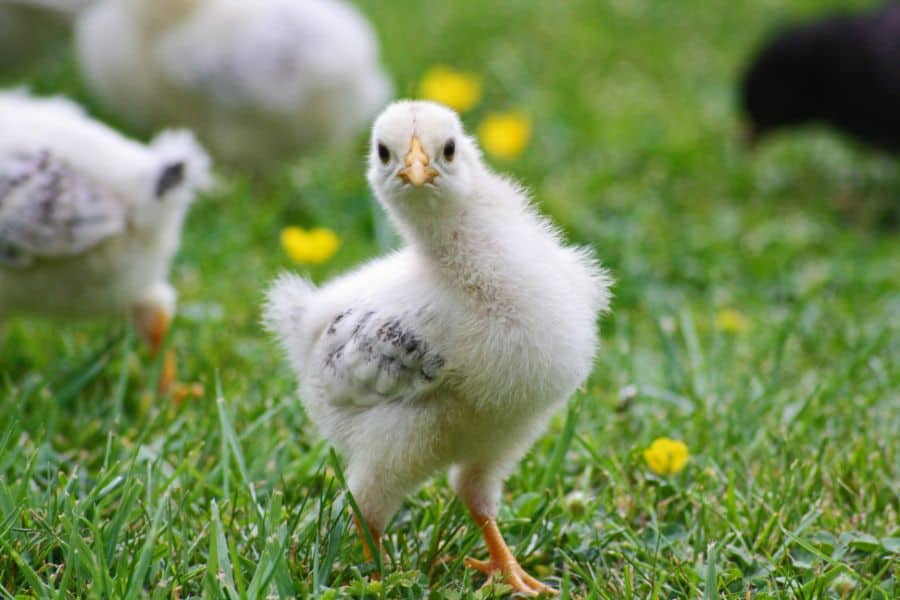If your cute and fluffy chickens are getting bored and restless, it may be time to change their environment. Chickens are delicate animals and can be quite sensitive to the manner in which you change their home.
You may have questions like when can chickens go outside? Is it safe to let them leave the coop? When can chickens stay outside at night?
Well, chickens are generally old enough to go outside between six and eight weeks. However, besides age, you must consider other factors like weather, predator activity, and more.
This article will discuss these important factors, including tips on how to introduce your chickens to the outdoors without putting them in harm’s way.
When Can Chicks Be Moved Outside?
Those cute and fluffy chickens will not remain fluffy forever. They’re fluffy because of their down feathers or plumules, which are soft but don’t provide enough protection from the cold.
Your chickens will eventually lose their down feathers and grow tougher feathers that can keep them warm when they’re outside. This usually happens around six to eight weeks, depending on the breed of chicken.
At this stage, you can start considering different ways to introduce them to the outer world. However, it’s not just their age that determines when it’s safe to allow chickens to go outside. Let’s consider some other factors that play a huge role in this decision.
5 Questions to Ask Yourself Before Moving Your Chickens Outside?
Even when your chickens have lost their down feathers, the weather, predator activity, chicken health, and temperature may still not favor the move. Let’s break down some of these factors and how to use them to determine when the time is right.
Are They Fully Feathered?
As chickens mature, they start to grow strong wings and tail feathers. That cute baby fuzz begins to disappear, and their color might start to change. This is a sign that they are getting ready to brave harsher weather conditions.
When chickens are fully feathered, they can regulate their body temperature and can be comfortable outside. To know when exactly your chickens have fully feathered, you may need to inspect them physically.
No two chickens are the same, and even though they might be the same age, they may fully feather out days from each other.
Usually, the last place you’ll find down feathers is the head. Once the down feathers have completely disappeared, you can start to acclimatize them to the weather outside.
Is the Temperature And Weather Favorable?
The weather outside needs to be warm enough during the day and night. Sometimes, it can be warm during the day, but the temperature might drop towards evening. As long as it does not drop below 60 degrees Fahrenheit at night, you’re good to go.
Besides how warm or cold it is, you also have to check certain weather elements, including wind, rain, and snow.
Older chickens might be able to withstand windy days, but younger chicks probably won’t. The best way to ensure your chickens do not catch a chill is by keeping them indoors till the wind, rain, and snow are completely gone.
As a rule of thumb, if there’s still snow on the ground, your chickens must remain indoors. Additionally, the sun can also get too hot for your chickens. As such, if you’re introducing them to an outdoor home, ensure you provide adequate shade for them.
Are There Any Predators Lurking Around?
If you don’t have any pets or potential predators living around, you have nothing to worry about. However, if you have larger animals present, you need to consider how their presence may prevent your chickens from getting comfortable outside.
Most animals larger than chickens are generally considered their predators. This includes animals like coyotes, foxes, possums, and skunks. Even pets like dogs and cats can be chicken predators.
As such, you must create a boundary between your coop area and other parts of your yard using fencing, mesh wires, or electric netting. You must also ensure that predators cannot find a way of breaking into the coop.
If the coop ever gets compromised, your chickens will mark it as a danger zone, and you may have a harder time getting them to come out again.
Are Your Chickens Healthy Enough?
Exposing your chickens to a different environment can put a strain on their health. Taking them to a new environment means you’re introducing them to different types of bacteria and other disease-causing organisms.
Hence, your fluffy gremlins must be healthy enough to withstand diseases without compromising their immune system. Before taking your chickens outside, ensure they are up to date with their vaccines while you support their well-being with healthy food.
Don’t get it wrong. Even chickens with the strongest immune systems can fall sick when they enter a new environment. However, they should easily get over this within a few days.
If you take your chickens outside and they fall ill without any signs of recovery, it is best to take them back inside as soon as you can. Symptoms of ill health that last longer than a few days may indicate more serious health conditions.
Are There Older Chickens Around?
While it is good for chickens to socialize, they may have a difficult time getting used to chickens from a different brood, especially if they are older. As such, it is often only advisable to introduce them to other chickens slowly.
The best way to make them comfortable is by taking them outside for a few hours each day before gradually increasing the hours.
If you’re trying to put younger chickens with older ones, keep them separated first before gradually merging them. Otherwise, the older chickens might scare off the younger ones due to their natural pecking order.
How to Safely Move My Chickens Outside?
If you’re ready to take your little ones outside, you must do it properly, or else you’re putting their health at risk. Here are some easy steps to take to make sure you’re doing it right.
Step 1: Gradually Reduce The Temperature
Baby chicks always require supplemental heat, but the need for extra warmth wanes as they grow. Research shows that when they are only a few days old, the place should be at least 95 degrees Fahrenheit hot or else they might develop heart problems.
With each week that passes, reduce the temperature by five degrees Fahrenheit to gradually introduce their bodies to the weather outside. If you adopt this method, your chickens will have an easier time getting used to the weather outside than if you suddenly take out the heat.
Step 2: Remove The Heating Lamps
Once you’ve taken the temperature down to a normal level, you can now take out the heating lamps or any other source of supplemental heat.
At this stage, your chickens have developed well enough to regulate their body temperature, so you’re not putting them at risk.
Once you take out the heating lamps, leave the chickens indoors for a few days before taking them outside. This helps them get used to the temperature inside first before they can adjust to the temperature outside.
Step 3: Take The Chickens Out Gradually
You can decide to take your chickens out in one day, but this may be more traumatizing to them.
A seamless way of introducing them outside would be by putting them in a large crate and taking them out for at least four to six hours each day. You can also keep them out on the grass, but ensure you separate them from older chickens by using a wire mesh or electric net.
Keep them outside longer each day till you’re confident that they can spend the night outdoors without any hassle.
Step 4: Provide Food And Water
Taking your chickens outside does not automatically guarantee that they can fend for themselves. Even though they may find scraps to peck on, you still need to make food and water accessible to them.
Ensure they have easy access to their feeders. You also want to keep their feeders in a safe location that is far from predators and other forms of contamination.
Step 5: Keep Them Supervised
Chickens are curious animals and can get into all sorts of trouble if you don’t keep a close eye on them. Don’t just take them outside and assume they’re okay. You must check on them every few hours.
Besides hurting themselves, predators can also smell them and come around. So, you must constantly supervise them, especially if the boundary isn’t high enough to keep them from certain animals or if you don’t have a layer of mesh to shield them from flying creatures.
It would help if you also supervised them to make sure they are not pecking at poisonous mushrooms or any plants that may be dangerous to them.
Also Read: DIY Chick Brooder Design Ideas
What Will Happen If I Take My Chickens Out Too Soon?
If you take your chickens outside sooner than you should, you’re putting them at risk of getting ill or, worse, dying. Chickens can die from simply being cold, so the biggest factor you have to consider is the warmth of your birds.
Sometimes, even after you observe all the steps explained above, your chickens may need more time to be ready to face colder temperatures.
Here are some signs to let you know if you’ve taken them out too soon;
- Huddling Together: Once your chickens are outside, they should naturally begin to roam about and explore. If you find them huddling together in a corner, they’re most likely trying to stay warm, and you should take them back inside or provide extra warmth.
- Extra Noisy: Yes, chickens are noisy creatures, and those birds will rarely ever stay silent except when they’re asleep. However, if you find them chattering more than usual, it may be a sign that they are uncomfortable.
- Sluggish Behavior: Even though chickens may be cautious of their new environment, they should not be afraid to explore. Chickens are at their best when they are allowed to run around. So if you find your birds acting slow and lethargic, there might be a problem.
- Puffed-Up Feathers: Chickens will do anything to keep warm. If you find them having puffed-up feathers, it might be an attempt to brave the cold weather. Take them inside and bring them back outside when the weather is more favorable.
FAQs
Like all chicken lovers, here are some questions you might find yourself asking.
When Can Chicks Go Outside Without A Heat Lamp?
Once the temperature outside matches the temperature of their brooder, chicks can be allowed to go outside to play.
Remember that you cannot control how hot or cold it gets outside, so ensure you keep an eye on the weather and take your chicks inside as soon as their temperature drops.
How Long Do Chicks Stay In The Brooder?
The brooding period usually lasts three to six weeks, depending on the climate, seasonal temperature, and breed of chicken. Sometimes chickens might need to remain in the brooder for up to eight weeks before they can comfortably go outside.
Conclusion
You can start taking your chickens out at six to eight weeks or when they are fully feathered out. A good way to start is by taking them out for a few hours each day before you take them out permanently.
If you start leaving them outdoors overnight, ensure the weather at night does not drop below 60 degrees Fahrenheit , as that is too cold. If you find your chickens huddling together or acting lethargic, they might not be ready to stay outside permanently yet.
Lastly, keep their coop area protected from predators and make food and water readily available to them.


